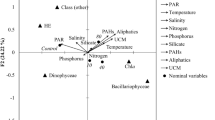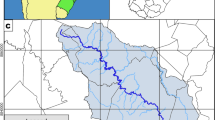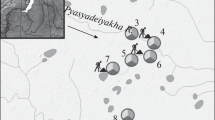Abstract
Oil spill pollution has remained a source of several international litigations in the Niger Delta region of Nigeria. In this paper, we examined the impacts of small recurrent crude oil spills on the physicochemical, microbial and hydrobiological properties of the Nun River, a primary source of drinking water, food and recreational activities for communities in the region. Samples were collected from six sampling points along the stretch of the lower Nun River over a 3-week period. Temperature, pH salinity, turbidity, total suspended solids, total dissolved solids, dissolved oxygen, phosphate, nitrate, heavy metals, BTEX, PAHs and microbial and plankton contents were assessed to ascertain the quality and level of deterioration of the river. The results obtained were compared with the baseline data from studies, national and international standards. The results of the physicochemical parameters indicated a significant deterioration of the river quality due to oil production activities. Turbidity, TDS, TSS, DO, conductivity and heavy metals (Cd, Cr, Cu, Pb, Ni and Zn) were in breach of the national and international limits for drinking water aquatic health. They were also significantly higher than the initial baseline conditions of the river. Also, there were noticeable changes in the phytoplankton, zooplankton and microbial diversities due to oil pollution across the sampling zones.

Similar content being viewed by others
References
Abowei, F. N., & Hart, A. I. (2009). Some morphormetric parameters of ten finfish species from the lower Nun River, Niger Delta Nigeria. Research Journal of Biological Sciences, 4(3), 282–288.
Abowei, J. F. N. (2010). Salinity, dissolved oxygen, pH and surface water temperature conditions in Nkoro River, Niger Delta, Nigeria. Advance Journal of Food Science and Technology, 2(1), 36–40.
Agedah, E. C., Ineyougha, E. R., Izah, S. C., & Orutugu, L. A. (2015). Enumeration of total heterotrophic bacteria and some physico-chemical characteristics of surface water used for drinking sources in Wilberforce Island, Nigeria. Journal of Environmental Treatreatment Techniques, 3(1), 28–34.
Alcaraz, M., Almeda, R., Calbet, A., Saiz, E., Duarte, C. M., Lasternas, S., Agustí, S., Santiago, R. D., Movilla, J., & Alonso, A. (2010). The role of arctic zooplankton in biogeochemical cycles: respiration and excretion of ammonia and phosphate during summer. Polar Biology, 33(12), 1719–1731.
Acosta-González, A., Martirani-von Abercron, S. M., Rosselló-Móra, R., Wittich, R. M., & Marqués, S. (2015). The effect of oil spills on the bacterial diversity and catabolic function in coastal sediments: a case study on the prestige oil spill. Environmental Science & Pollution Research, 22(20), 15200–15214.
Aghoghovwia, O. A., & Ohimain, E. I. (2014). Physicochemical characteristics of lower Kolo creek, Otuogidi, Bayelsa state. Nigerian Journal of Agriculture, Food and Environment, 10(1), 23–26.
Alabaster, J. S., & Lloyd, R. (1980). Water quality criteria for freshwater fish. Internal Review of Hydrobiology, 66(3), 297.
Allan, S. E., Smith, B. W., et al. (2012). Impact of the deepwater horizon oil spill on boavailable polycyclic aromatic hydrocarbons in Gulf of Mexico coastal waters. Environmental Science & Technology, 46(4), 2033–2039.
Aloulou, F., Kallell, M., & Belayouni, H. (2011). Impact of oil field-produced water discharges on sediments: a case study of Sabkhat Boujemal, Sfax, Tunisia. Environmental Forensics, 12(3), 290–299.
Almeda, R., Wambaugh, Z., Chai, C., Wang, Z., Liu, Z., & Buskey, E. J. (2013). Effects of crude oil exposure on bioaccumulation of polycyclic aromatic hydrocarbons and survival of adult and larval stages of gelatinous zooplankton. PloS One, 8(10), e74476.
APHA. (2005). Standard methods for examination of water and wastewater. Washington DC: American Public Health Association.
Asonye, C. C., Okolie, N. P., Okenwa, E. E., & Iwuanyanwu, U. G. (2007). Some physico-chemical characteristics and heavy metal profiles of Nigerian rivers, streams and waterways. African Journal of Biotechnology, 6(5), 617.
Barros, Á., Álvarez, D., & Velando, A. (2014). Long-term reproductive impairment in a seabird after the prestige oil spill. Biology Letters, 10(4), 20131041.
Beadle, L.C. (1974). The inland waters of tropical Africa. An introduction to tropical limnology. Longman Group Ltd, Publishers, 74 Grosvenor Street, London W. 1.
Bhattacharya, D., Clement, T. P., & Dhanasekaran, M. (2016). Evaluating the neurotoxic effects of Deepwater Horizon oil spill residues trapped along Alabama’s beaches. Life Sciences, 155, 161–166.
Beyer, J., Trannum, H. C., Bakke, T., Hodson, P. V., & Collier, T. K. (2016). Environmental effects of the Deepwater Horizon oil spill: a review. Marine Pollution Bulletin. doi:10.1016/j.marpolbul.2016.06.027.
Brettum, P., Andersen, T. (2005). The use of phytoplankton as indicators of water quality Norwegian Institute for Water Research Report.
Brussaard, C. P., Peperzak, L., Beggah, S., Wick, L.Y., Wuerz, B., Weber, J., Arey, J.S., van der Burg, B., Jonas, A., Huisman, J. and van der Meer, J.R. (2016). Immediate ecotoxicological effects of short-lived oil spills on marine biota. Nature Communication, 7.
Buchanan, R. E., & Gibbons, N. E. (2001). Bergey’s manual of determinative bacteriology. Baltimore: Williams and Wilkins Co.
Cam, D., Gagni, S., Meldolesi, L., & Galletti, G. (2000). Determination of polycyclic aromatic hydrocarbons in sediment using solid-phase microextraction with gas chromatography—mass spectrometry. Journal of Chromatographic Science, 38(2), 55–60.
Cruickshank, R., Duguid, J. P., et al. (1975). Medical microbiology, the practise of medical microbiology. Edinburgh, London and New York: Churchill Livingstone Limited.
Dawes, C. J. (1998). Marine Botany. New York: Wiley.
DEHP. (2016) Ecosystem health indicators’ department for environment and heritage protection Queensland government.
Department of Petroleum Resources (DPR) (2002). Environmental Guidelines and Standards for the Petroleum Industry in Nigeria (EGASPIN), pp 59–66.
Dubinsky, E. A., Conrad, M. E., Chakraborty, R., Bill, M., Borglin, S. E., Hollibaugh, J. T., Mason, O. U., Piceno, M. Y., Reid, F. C., Stringfellow, W. T., & Tom, L. M. (2013). Succession of hydrocarbon-degrading bacteria in the aftermath of the Deepwater Horizon oil spill in the Gulf of Mexico. Environmental Science & Technology, 47(19), 10860–10867.
Duursma, E. K., & Dawson, R. (1981). Marine organic chemistry: evolution, composition, interaction and chemistry of organic matter in seawater. Amsterdam; New York: Elsevier.
Ezekiel, E. N., Hart, A. I., & Abowei, F. F. N. (2011). The sediment physical and chemical characteristics in Sombreiro River, Niger Delta, Nigeria. Research Journal of Environmental and Earth Science, 3(4), 341–349.
Ezekwe, I. C., Chima, G. N., & Ikogori, G. (2013). An investigation of selected microbial pollutants in groundwater sources in Yenegoa town, Bayelsa, Nigeria. Estudos de Biologia, 35(84), 77–84.
Fattal, P., Maanan, M., Tillier, I., Rollo, N., Robin, M., & Pottier, P. (2010). Coastal vulnerability to oil spill pollution: the case of Noirmoutier Island (France). Journal of Coastal Research, 26(5), 879–887.
Fiedler, S., Siebe, C., Herre, A., Roth, B., Cram, S., & Stahr, K. (2009). Contribution of oil industry activities to environmental loads of heavy metals in the Tabasco Lowlands, Mexico. Water Air and Soil Pollution, 197(1–4), 35–47.
Guo, Y., & Yang, S. (2016). Heavy metal enrichments in the Changjiang (Yangtze River) catchment and on the inner shelf of the East China Sea over the last 150 years. Science of the Total Environment, 543, 105–115.
Hazen, T. C., Dubinsky, E. A., DeSantis, T. Z., Andersen, G. L., Piceno, Y. M., Singh, N., Jansson, J. K., Probst, A., Borglin, S. E., Fortney, J. L., & Stringfellow, W. T. (2010). Deep-sea oil plume enriches indigenous oil-degrading bacteria. Science, 330(6001), 204–208.
Heathcote, I. W. (2009). Integrated watershed management: principles and practise. New Jersey: John Wiley & Sons.
Imevbore, A.M.A. (1983). The investigation of faecal pollution in the surface water of the Niger Delta of Nigeria: final report Niger Delta Basin Development Authority, Niger Delta Basin Development Authority.
IUCN Niger – Delta Panel. 2013. Sustainable Remediation and Rehabilitation of Biodiversity and Habitats of Oil Spill Sites in the Niger Delta. Main Report including recommendations for the future. A report by the independent IUCN—Niger Delta Panel (IUCN-NDP) to the Shell Petroleum Development Company of Nigeria (SPDC). January 2013. Gland, Switzerland: IUCN.
Jacob, P. G., & Al-Muzaini, S. (1995). Marine plants of the Arabian Gulf and effects of oil pollution. Mahasagar, 28(1–2), 83–101.
Jarup, L. (2003). Hazard of heavy metal contamination. British Medical Bulletin, 68(1), 167–182.
Jung, S. W., Kwon, O. Y., Joo, C. K., Kang, J. H., Kim, M., Shim, W. J., & Kim, Y. O. (2012). Stronger impact of dispersant plus crude oil on natural plankton assemblages in short-term marine mesocosms. Journal of Hazardous Materials, 217, 338–349.
Kadafa, A. A. (2012). Oil exploration and spillage in the Niger Delta of Nigeria. Civil and Environmental Research, 2(3), 38–51.
Kamath, S., Sabatini, D. A., & Canter, L. W. (1991). Biological nitrification/denitrification of high sodium nitrite (navy shipyard) wastewater. Environmental Pollution, 69(1), 25–38.
Lotufo, G. R. (1998). Bioaccumulation of sediment-associated fluoranthene in benthic copepods: uptake, elimination and biotransformation. Aquatic Toxicology, 44(1), 1–15.
Moliner-Martínez, Y., Herraez-Hernandez, R., Verdú-Andres, J., Campíns-Falcó, P., Garrido-Palanca, C., Molins-Legua, C., & Seco, A. (2013). Study of the influence of temperature and precipitations on the levels of BTEX in natural waters. Journal of Hazardous Materials, 263, 131–138.
Mulusky, D. S. (1974). Ecology of estuaries, Heinemann educational books.
Murphy, J., & Riley, J. P. (1962). A modified single solution method for the determination of soluble phosphate in natural waters. Analytica Chimica Acta, 26, 31–36.
Nyananyo, B. L. (1999). Vegetation. In: Alagoa E. J (ed). The land and people of Bayelsa State: central Niger Delta. Onyoma Publications P44.
Nyananyo, B. L., Gijo, A. H., & Ogamba, E. N. (2007). The physico-chemistry and distribution of water hyacinth (Eichhornia cressipes) on the river Nun in the Niger Delta. Journal of Applied Science and Environmental Management., 11(3), 133–137.
Nelson-Smith, A. (1993). Oil pollution and marine ecology. New York: Plenum Press.
Odokuma, L. O., & Okpokwasili, G. C. (1993). Seasonal influences on inorganic anion monitoring of the new Calabar River, Nigeria. Environmental Management Journal, 17(4), 491–496.
Ordinioha, B., & Brisibe, S. (2013). The human health implications of crude oil spills in the Niger Delta, Nigeria: An interpretation of published studies. Nigerian Medical Journal, 54(1), 10.
Ozhan, K., & Bargu, S. (2014). Distinct responses of Gulf of Mexico phytoplankton communities to crude oil and the dispersant Corexit® Ec9500A under different nutrient regimes. Ecotoxicology, 23(3), 370–384.
Prat, N., Toja, J., Sola, C., Burgos, M. D., Plans, M., & Rieradevall, M. (1999). Effect of dumping and cleaning activities on the aquatic ecosystems of the Guadiamar River following a toxic flood. Science of the Total Environment, 242(1), 231–248.
Reiss, H., & Kröncke, I. (2005). Seasonal variability of benthic indices: an approach to test the applicability of different indices for ecosystem quality assessment. Marine Pollution Environment, 50(12), 1490–1499.
Risser, P. G., & Rice, E. L. (1971). Diversity in tree species in Oklahoma Upland. Ecology, 52(5), 876–880.
Seiyaboh, E. I., Ekweozor, I. K. E., Ogamba, E. N., & Alagha, W. E. (2007). Effect of Tombia bridge construction on the water quality of Nun River in Central Niger Delta, Nigeria. Journal of Applied Sciences, 10(3), 7148–7156.
Selala, M.C., Oberholster, P.J., Surridge, K.A., de Klerk, A.R. & Botha, A.M. (2013). Responses of selected biota after biostimulation of a vegetable oil spill in the Con Joubert Bird Sanctuary wetland: a pilot study. African Journal of Biotechnology, 12 (4).
Sikoki, F. D., Hart, A. I., & Abowei, J. F. N. (1998). Gill net selectivity and fish abundance in the lower Nun river. Nigeria Journal of Applied Science and Environmental Management, 1, 13–19.
SPDC (2015). Final Environmental Impact Assessment (EIA) report for the Adibawa-Gbaran 3D Reshoot Seismic Data Acquisition Project in Bayelsa and Rivers States, November 2015.
Swaney, D. P., Howarth, R. W., & Butler, T. J. (1999). A novel approach for estimating ecosystem production and respiration in estuaries: application to the oligohaline and mesohaline Hudson River. Limnology and Oceanography, 44(6), 1509–1521.
Talling, J. F. (2010). pH, the CO2 system and freshwater science. Freshwater Reviews, 3(2), 133–146.
United National Environmental Programme (UNEP) (2011). Environmental assessment of Ogoniland. Nairobi pp. 1–262.
Yakimov, M. M., Timmis, K. N., & Golyshin, P. N. (2007). Obligate oil-degrading marine bacteria. Current Opinion in Biotechnology, 18(3), 257–266.
Zhang, Z., Wang, J. J., Tang, C., & DeLaune, R. D. (2015). Heavy metals and metalloids content and enrichment in Gulf Coast sediments in the vicinity of an oil refinery. Journal of Geochemical Exploration, 159, 93–100.
Zhang, J., Yan, J. & Zhang, Z. F. (1995). Nationwide river chemistry trends in China: Huanghe and Changjiang. Ambio, 275–279.
Acknowledgements
The authors would like to thank Dr. Alex Onojeghuo of Lancaster Environment Centre and Southsea Datcomm Laboratory Limited for their support.
Author information
Authors and Affiliations
Corresponding author
Rights and permissions
About this article
Cite this article
Ifelebuegu, A.O., Ukpebor, J.E., Ahukannah, A.U. et al. Environmental effects of crude oil spill on the physicochemical and hydrobiological characteristics of the Nun River, Niger Delta. Environ Monit Assess 189, 173 (2017). https://doi.org/10.1007/s10661-017-5882-x
Received:
Accepted:
Published:
DOI: https://doi.org/10.1007/s10661-017-5882-x




